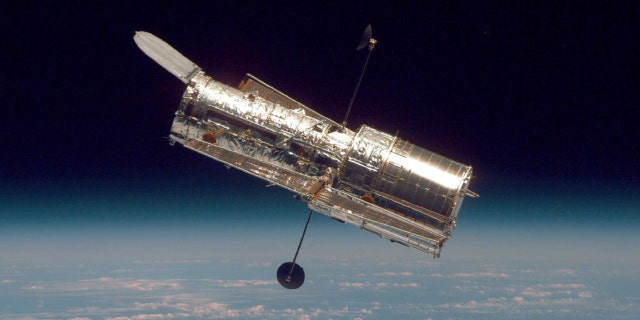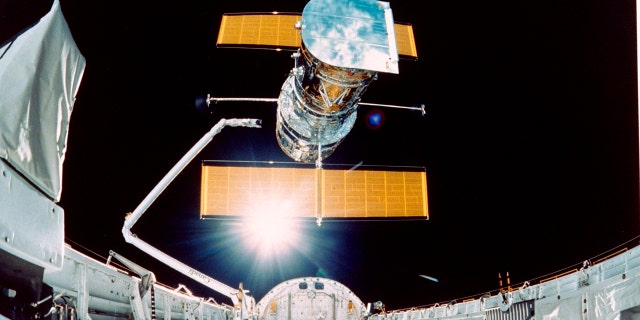NASA’s Hubble Area Telescope peered into the middle of an unlimited galaxy cluster in a good looking new picture.
The European Area Company (ESA) stated the cosmic big – known as eMACS J1823.1+7822 – could be recognized by the distortions in space-time surrounding it.
The mass of the cluster has brought on the pictures of background galaxies to be gravitationally lensed.
Gravitational lensing happens when a celestial object has such an enormous gravitational pull that it warps time and house round it, bending the sunshine from a extra distant object and magnifying it.
WEBB TELESCOPE SNAPS SHOT OF FIRST ASTEROID BELT EVER SEEN OUTSIDE THE SOLAR SYSTEM
A cluster of enormous galaxies, surrounded by varied stars and smaller galaxies on a darkish background. The central cluster is generally made from vibrant elliptical galaxies which can be surrounded by a heat glow. Near the cluster core is the stretched, distorted arc of a galaxy, gravitationally lensed by the cluster. (Credit score: ESA/Hubble & NASA, H. Ebeling)
The company stated the cluster had brought on a adequate curvature of space-time to bend the trail of sunshine and trigger background galaxies to look distorted into streaks and arcs of sunshine.
Different galaxies could be seen surrounding the cluster, in addition to foreground stars with signatory diffraction spikes.
The galaxy cluster lies practically 9 billion light-years away within the constellation Draco.

On this handout from NASA, the Hubble Area Telescope drifts via house in an image taken from the Area Shuttle Discovery throughout Hubble’s second servicing mission in 1997. ((Picture by NASA by way of Getty Photographs))
It’s one in every of 5 clusters explored by the telescope, with the goal of measuring the strengths of those gravitational lenses and gaining a greater understanding of the distribution of darkish matter in galaxy clusters.
NEW JERSEY POLICE INVESTIGATE POSSIBLE METEORITE THAT CRASHED INTO HOME
“Robust gravitational lenses like eMACS J1823.1+7822 will help astronomers examine distant galaxies by appearing as huge pure telescopes which amplify objects that will in any other case be too faint or distant to resolve,” the ESA defined.

Image taken by the STS-31 crew aboard the Area Shuttle Discovery displaying the Hubble Area Telescope being deployed on April 25, 1990, from the payload bay. (Picture by -/NASA/AFP by way of Getty Photographs)
The picture contains knowledge from eight totally different filters and Hubble’s Superior Digicam for Surveys and Broad Area Digicam 3.
Each of the devices are in a position to view astronomical objects in only a small slice of the electromagnetic spectrum utilizing filters, which allow scientists to seize objects at exactly chosen wavelengths.
CLICK HERE TO GET THE FOX NEWS APP
Combining observations at totally different wavelengths permits astronomers to see a extra full image of an object than simply seen gentle.


